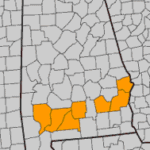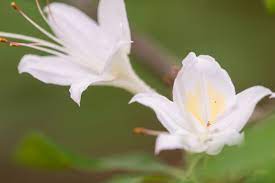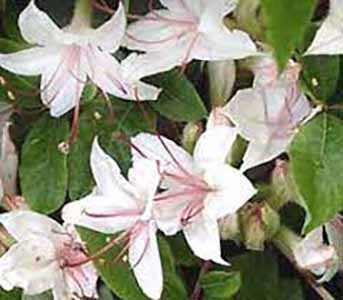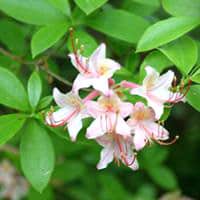THE "WHITE GROUP"
The “White Group” includes seven species, six of which have been found growing in the Eastern United States and Canada, and one, R. occidentale, found growing wild on the West Coast. The six Eastern species are: R. alabamense, R. arborescens, R. atlanticum, R. viscosum, a recently identified species from South Carolina, R. eastmanii, and a second new species from Alabama, R. colemanii.
R. alabamense
Rhododendron alabamense, or the Alabama Azalea, has snowy white flowers with a prominent yellow blotch. Blooming in midseason, the flowers have a distinct lemon-spice fragrance and measure 0.8 to 1.5 inches across.
Originally thought to be a white form of R. periclymenoides (R. nudiflorum), this plant was first described by Dr. C. Mohr in 1883. It grows naturally in north central Alabama, and western to central Georgia and South Carolina.
R. alabamense is low to medium in height, and spreads by underground stems or stolons. It propagates with relative ease from soft wood cuttings and makes a delightful landscape plant.
This species is found in Alabama and adjacent Tennessee, and Georgia and Florida. Its habitat is upland woods, bluffs and hillsides, along watercourses, and in stream bottoms from about sea level to 500 m (1700 ft). Its main flowering season is April and May, but sometimes it blooms in March or June. Rhododendron alabamense has a limited distribution and is threatened by development and in northern Alabama by strip mining.
R. arborescens
Rhododendron arborescens, the Sweet Azalea, has white to blush pink flowers with red stamens, and a very strong fragrance similar to heliotrope. It blooms in late spring to early summer.
First described by John Bartram in 1814, this species has a wide distribution in the eastern United States, but can usually be found growing near streams or moist areas. It is sometimes known as the "Smooth Azalea" because the stems are very smooth and do not have hairs similar to the other azaleas.
An excellent landscape plant, R. arborescens can perfume a wide area when in bloom. Relatively easy to propagate, there are a number of excellent forms in the trade.
Rhododendron arborescens is found in West Virginia, Tennessee, North Carolina, Georgia and Alabama. Its habitat is along mountain streams, on shrub balds and in moist woods at elevations of 300 to 1500 m (1000 to 5000 ft). Flowering is from May to August, and occasionally as early as April or as late as September. This species helps hold stream banks with its fibrous root system and is somewhat impacted by development.
R. atlanticum
Rhododendron atlanticum, the Coastal Azalea, is a common understory plant along the south eastern coastal plains of the United States. The white flowers are 1 to 1.5 inches across, but are often blushed with pink on the outside and some have a yellow blotch.
Collected by John Clayton in 1743, this plant was appreciated more in England than in its native land. The plant habit is relatively low but stoloniferous. Spreading by underground stems, R. atlanticum can develop into very large colonies of an acre or more in sandy soils.
R. atlanticum is easy to propagate, and makes a nice landscape plant in heavier soils which will restrict the spreading habit.
This species extends from Delaware to southeastern Georgia along the Atlantic Coastal Plain. It grows in sandy pinelands, swamps, shrub bogs, and along streams at sea level to 150 m (500 ft). It usually flowers in April and May, although it may flower as early as March. Rhododendron atlanticum grows in an area where population is expanding very rapidly along the East Coast. Besides threats from business and housing developments, some treatments for vegetation control under power lines are diminishing its numbers.
R. colemanii
R. colemanii, commonly called the Red Hills Azalea, was first described in 2008 from material collected in Monroe County, Alabama. It occurs on sandy ridges and banks of streams and on moist north-facing hardwood slopes in hardwood forests. Its range is confined to the Red Hills area of Alabama and a small area of adjacent west Georgia. Unlike most of our native deciduous azaleas, the Red Hills Azalea is a tetraploid (having twice the normal number of chromosomes or 4N). It shares this trait with Rhododendron atlanticum, Rhododendron austrinum, Rhododendron calendulaceum, and the old world Rhododendron luteum. These species make up a monophyletic group, sharing a common ancestor unique only to them.
The Red Hills Azalea is a multi-stemmed shrub reaching 20 feet in height. Leaves are deciduous, alternate, obovate to oblong in outline, with entire ciliate margins. The leaves are pubescent along the midvein on the upper surface with multicellular hairs. The lower surface is glabrous or pubescent with unicellular and scattered multicellular hairs. The midvein on the lower surface of the leaf is pubescent with appressed multicellular hairs. Flowers are produced in terminal racemes after the leaves are fully expanded. The pedicels of the flowers are densely covered with unicellular and multicellular glandular hairs. Flower color varies widely from white with a yellow blotch on the upper corolla lobe, to uniformly white, pink with yellow blotch, or uniformly pink, to rarely yellow. The outside of the flowers are covered with unicellular and multicellular gland-tipped hairs. The flowers are fragrant with a sweet, musky or lemony odor. The fruit is a cylindrical capsule with prominent raised warty bumps toward the tip, and sparsely to densely covered with unicellular and multicellular eglandular hairs, often with glandular-tipped multicellular hairs at the base. Although it is a recently described species, the Red Hills Azalea is widely available in the horticulture trade. Plants do best in a moist, organic rich, acidic soil with good drainage. Plants grow and flower best in partial sun. Too much sun can lead to leaf damage in the summer, and too much shade will cause plants to become leggy with few flowers.
Recommended for further reading:
Rhododendron colemanii: A New Species of Deciduous Azalea (Rhododendron section Pentanthera; Ericaceae) from the Coastal Plain of Alabama and Georgia, Wenyu Zhou, Taylor Gibbons, Loretta Goetsch, Benjamin Hall, Thomas Ranney, and Ron Miller, available at https://www.ces.ncsu.edu/fletcher/staff/tranney/colemanii.pdf

Distribution
R. eastmanii
Rhododendron eastmanii is a very rare species growing in only a few locations in two South Carolina counties. The current known population is on the order of only 500 plants. Only recently discovered, and its existence first published in November 1999 by Dr. Kathleen Kron and Mike Creel, this is the newest native azalea species. Selected forms are being propagated and will be distributed to the the public in time, so please do not disturb any plants in the wild. Appreciate this rare and beautiful species, and please assist those who are trying to protect its native habitat.
Like several of the native azaleas in the "white group", R. eastmanii flowers after the leaves have expanded. It is clearly different from R. arborescens with the familiar red stamens, since R. eastmanii's stems are not smooth but are covered with hairs, or pubescense. In many ways, it is more closely aligned with the west coast native, R. occidentale, but is obviously different due to its geographical isolation and some other minor characteristics.
Rare species discovered in South Carolina in 1995. Flowers white with yellow blotch and red stamens. Fragrant.
Recommended for further reading:
A new species of deciduous azalea (Rhododendron section Pentanthera; Ericaceae) from South Carolina, M Creel, K A Kron, Novon 1999 9:377-380
OUR EASTERN NATIVE AZALEAS IN THE TWENTY-FIRST CENTURY, Sandra F. McDonald, Journal of the American Rhododendron Society 55 no 3, Summer 2001

Photo M Creel
R. occidentale
Rhododendron occidentale is the only native azalea that grows naturally west of the Rocky Mountains in the United States. It is a difficult garden plant in the South Eastern United States, and seems to object to the heat and humidity that often accompany the summers there.
R. occidentale was discovered in the 19th century and specimens taken to England, where it was used in the development of the Exbury azaleas.
Much of the characterization of R. occidentale in the 20th century was done by Frank Mossman and Britt Smith and is described in a pair of QBARS articles listed below.
In 2010, the Smith-Mossman Western Azalea Display Garden was dedicated in the Lake Wilderness Arboretum in Washington--see JARS and Pacific Horticulture references below.
Michael McCullough has continued to search for specimens along the Pacific states, particularly concentrating on collections in Southern California. His hybridization efforts have continued to this day.
Recommended for further reading:
RHODODENDRON OCCIDENTALE - ONE SPECIES OR MANY?, Frank D. Mossman, M.D., and Britt M. Smith, Quarterly Bulletin of the American Rhododendron Society Vol. 23 No 3, available at http://scholar.lib.vt.edu/ejournals/JARS/v23n3/v23n3-mossman.htm
FURTHER TRIPS TO THE RHODODENDRON OCCIDENTALE PATCHES, Frank D. Mossman, and Britt Smith, Quarterly Bulletin of the American Rhododendron Society Vol. 22 No 3, available at http://scholar.lib.vt.edu/ejournals/JARS/v22n3/v22n3-mossman.htm
DEDICATION OF THE SMITH-MOSSMAN WESTERN AZALEA DISPLAY GARDEN,
Bob Dunning, Journal of the American Rhododendron Society Vol 54 No 4, available at http://scholar.lib.vt.edu/ejournals/JARS/v54n4/v54n4-dunning.htm
Smith-Mossman Western Azalea Garden by: Rick Peterson Richie Steffen, Pacific Horticulture April 2010, available at http://www.pacifichorticulture.org/articles/smith-mossman-western-azalea-garden/
EXPLORING FOR THE WESTERN AZALEA IN SOUTHERN CALIFORNIA, Michael A. McCullough, Journal of the American Rhododendron Society Vol 39 No. 2, available at http://scholar.lib.vt.edu/ejournals/JARS/v39n2/v39n2-mccullough.htm
R. viscosum
Rhododendron viscosum now includes two closely related forms that were previously considered separate species, R. serrulatum and R. oblongifolium. The fragrant flowers are generally white to pale pink, and bloom after the leaves have fully expanded. Flowers vary in size from 0.75 to 1.5 inches across depending upon the form, but have a long narrow tube covered with sticky glandular hairs. The species has a wide distribution from Maine to Florida, and westward to Texas.
R. viscosum</b> was the first North American azalea grown in England. Bishop Henry Compton raised the plant in 1680 from seed collected by John Bannister, an English Missionary. The species was an important parent in early hybridizing efforts with deciduous azaleas. It can be distinguished from the other late blooming white, R. arborescens in that the stamens are greenish white rather than red, and the stems are not smooth but contain hairs.
This is a very wide-ranging species from Vermont and Maine to the Florida peninsula and west to Texas and north to Arkansas. Rhododendron viscosum has been segregated into as many as four species: R. coryi , R. oblongifolium , R. serrulatum , and R. viscosum . It can be found in wet habitats along stream banks, swamps, low flatwoods, shrub balds and acid bogs, from sea level to 1500 m (5000 ft). It may flower as early as March in some areas and as late as December at the southern limits of its range. Rhododendron viscosum has a wide distribution but is noticeably depleted in built-up areas where it used to grow.




































